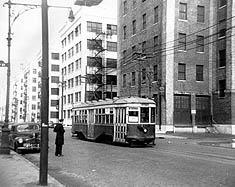| Life
in Brooklyn: Neighborhoods |
||
| Home Immigration Life in Brooklyn Assimilation Research
|
Sunset Park
View from Sunset park overlooking Harbor and World Trade Center (for more pix http://streetlights.tripod.com/bklyn/sunset/sunset.html ) History Named for a park on the ridge line, the Sunset Park neighborhood has gone through many ethnic changes and is a microcosm of many of the immigration waves that transformed the city. In its heyday in the late nineteenth and early twentieth century, the Brooklyn waterfront was more prosperous than Manhattan's waterfront. It encompassed hundreds of acres of enormous basins, dry docks, storage warehouses and storehouses for bulk goods (such as coffee and grain), shipbuilding and repair facilities, sugar refineries, and thousands of feet of piers. My grandfather worked on these piers. Following the Irish in the mid 1800s, a Scandinavian community was among the first ethnic groups to establish itself in Sunset Park starting in the late 1800s leaving an imprint which still persists today both in residents and institutions like the Lutheran Medical Center.
Brooklyn waterfront in Sunset Park, 1926 Also around 1880, a Polish community took root near Third Avenue and 20th street. The Ansonia Clock factory employed many Polish men and many found work in the nearby Greenwood cemetery at fourth and 25th street. By 1890, a largely Catholic Polish community was established along Third Avenue in Sunset Park. Our Lady of Czestochowa was a center of worship in the community.
Streetcars ran on 2nd and 3rd avenue Around the turn of the century, Italians moved into the neighborhood followed by Puerto Ricans after World War II and today Chinese and other Asians. Today, it is largely Latino, with a heavy Puerto Rican, Dominican, Mexican and Central American presence. The Brooklyn Historical Society recently sponsored an exhibit covering the Chinese who live in the 8th avenue area of Sunset Park. Sunset Park is divided by freeways including the Gowanus. Urban planners and other groups are trying to propose alternative development for the area. Businesses 1. Bush Terminal
Former Brooklyn Army Terminal 2. Brooklyn Army Terminal (BAT)
3. Lutheran Medical Center Churches and Schools
The church of Our Lady of Perpetual Help at 5th and 59th is the largest church in Brooklyn. Sources Snyder-Grenier, Ellen M. Brooklyn! An Illustrated History Philadelphia:Temple University Press, 1996. |
![]()



